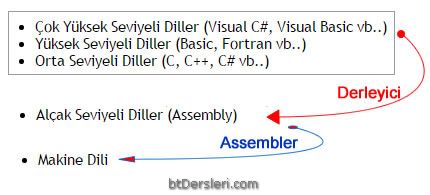Programming Language
All programs are written in programming languages. These languages have the necessary commands and idioms to make the computer do certain jobs. They also have their own unique spelling rules.
Programming languages are classified as:
-
Very High Level Languages (Visual C#, Visual Basic etc.)
-
High Level Languages (Basic, Fortran etc.)
-
Intermediate Languages (C, C++, C# etc.)
-
Low Level Languages (Assembly)
-
Machine Language

Programmers prefer high-level languages when writing programs. Because programming in these languages is easier and more understandable.
The programs we write with high level languages are first translated into assembly language by compiler programs. It is then translated into machine language and run by the computer.
The compiler program that translates assembly language into machine language is called "assembler".
What is Machine Language?
The language that the computer can understand, consisting of 0s and 1s, is called machine language.
In order for the computer to understand and run the programs that we have written in any language, they must first be translated into machine language.
Programs called “Compiler” perform the work of translating the program we wrote into machine language. Each programming language has its own compiler program. In this way, the programs we write are translated into machine language and run by the computer.
Programming Languages and Machine Language, What is machine language, what is assembler, what is assembly, what is compiler, which programming language should I prefer, high level languages
EXERCISES
There are no examples related to this subject.
Read 1534 times.